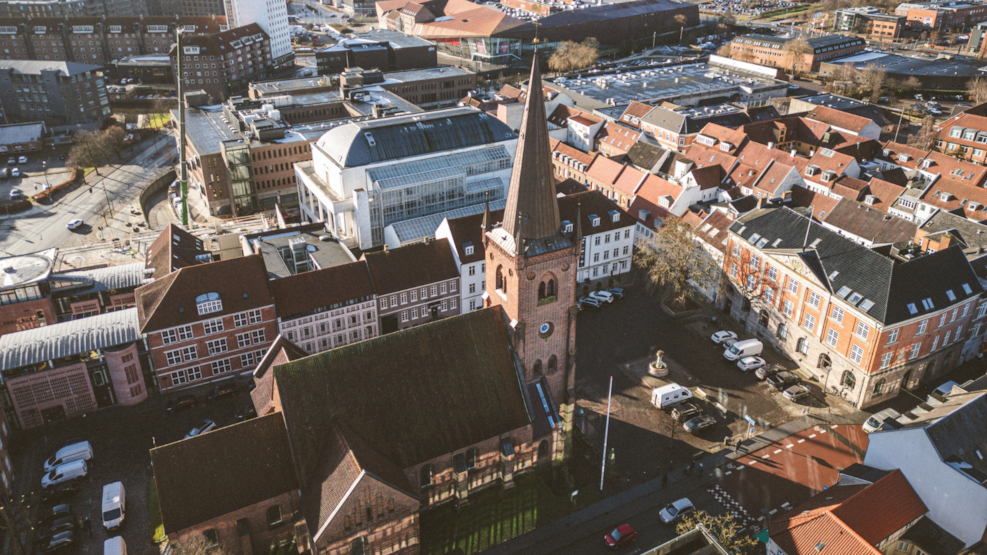
Sankt Nicolai Church
St. Nicolai Church is an integral part of the vibrant urban space. Located in the heart of Vejle, on Kirketorvet, the church is visited annually by many tourists and locals. Not only is it Vejle’s oldest building, it is also the only preserved structure from the Middle Ages. Therefore, the church is not just a place for religious ceremonies but also a space for meetings and culture, where it feels natural and exciting to encounter both historical and modern art.
St. Nicolai Church was built between 1240 and 1280 as a late Romanesque–early Gothic longhouse. Over time, it was expanded with a small tower, a southern side aisle, and two transepts. In 1855, the church received a new chancel, and in 1887 the old tower was demolished and replaced in 1888 with the current Neo-Gothic tower.
On the church’s north side, facing Kirkegade, you can see 23 round holes containing embedded human skulls. Legend has it they belonged to executed robbers who terrorised peaceful citizens from their hideout in Nørreskoven over 300 years ago.
Inside the church is a special burial chapel, Kai de la Mare’s Chapel. In 1704, Lieutenant Colonel de la Mare donated 100 rigsdalers to the church to establish a family burial site in the southern chapel. During a renovation in 1862, it was moved to the northern chapel. Today, it holds three family coffins, a fourth unknown one, and a photo of “Queen Gunhild,” a bog body discovered in 1835 in Haraldskær Bog, currently on loan to the Cultural Museum at Spinderihallerne.
The two great reformers, Luther and Melanchthon, are portrayed in paintings by the workshop of Lucas Cranach the Younger in Wittenberg. These portraits hang on the church’s north wall and were donated by a pastor’s widow in 1585. Vejle’s famous historian Anders Sørensen Vedel is also portrayed here. A large commemorative portrait by Jørgen Roed from 1860 was donated by, among others, Governor Orla Lehmann.
St. Nicolai Church underwent a major renovation and rebuild in 2018–2019, with architecture firm EplusN. The church was whitewashed anew and received a new heating system, colour scheme, modern movable chairs, electrical and lighting upgrades, a new sound system, accessible entrances, and significantly improved toilet facilities. The rebuild also included parish facilities such as classrooms, meeting rooms, a baptism room, and a pastor’s office.
The chancel and altar area were entirely redesigned. The old altar has been mounted in the southern transept. Artist Anders Kirkegaard created a new altarpiece, inaugurated on 14 November 2021. This unique large-scale painting stands as a more than five-metre-tall triptych in violet, red, and green. During services, the top panel unfolds to reveal a resurrection scene featuring Vejle Fjord. Kirkegaard calls it his masterpiece — “My testament,” he says.
A new communion rail and altar table were installed, but the pulpit from 1576 remains unchanged. The church’s oldest piece of furniture, the baptismal font from before 1250, has been moved to a spot below the chancel steps.
For the design of the glass partitions enclosing the new rooms beneath the organ loft, the church chose the textile artists Beck & Kinch of Aarhus — known for working with major fashion houses like Dior and Chanel, as well as the FAO and the Danish Ministry of Foreign Affairs.